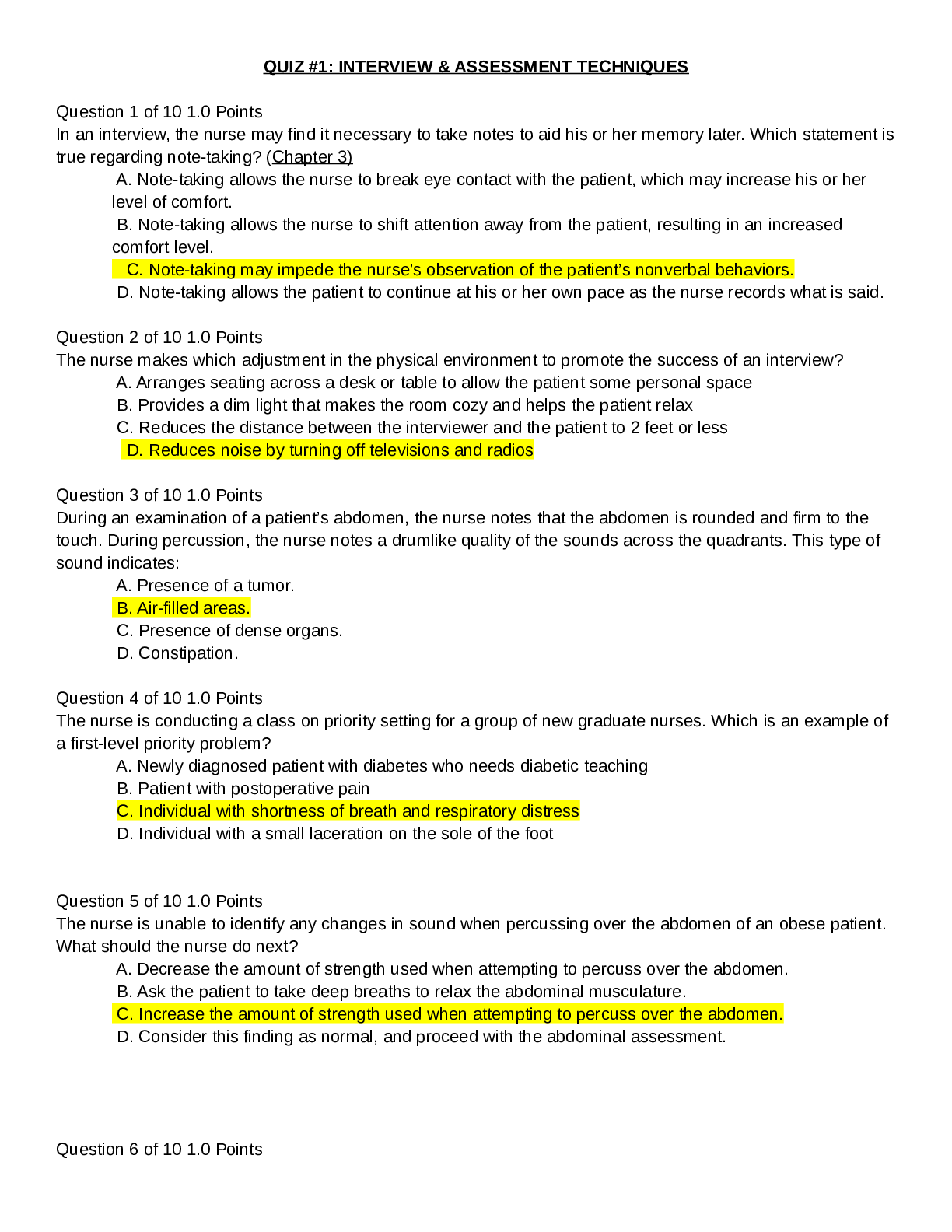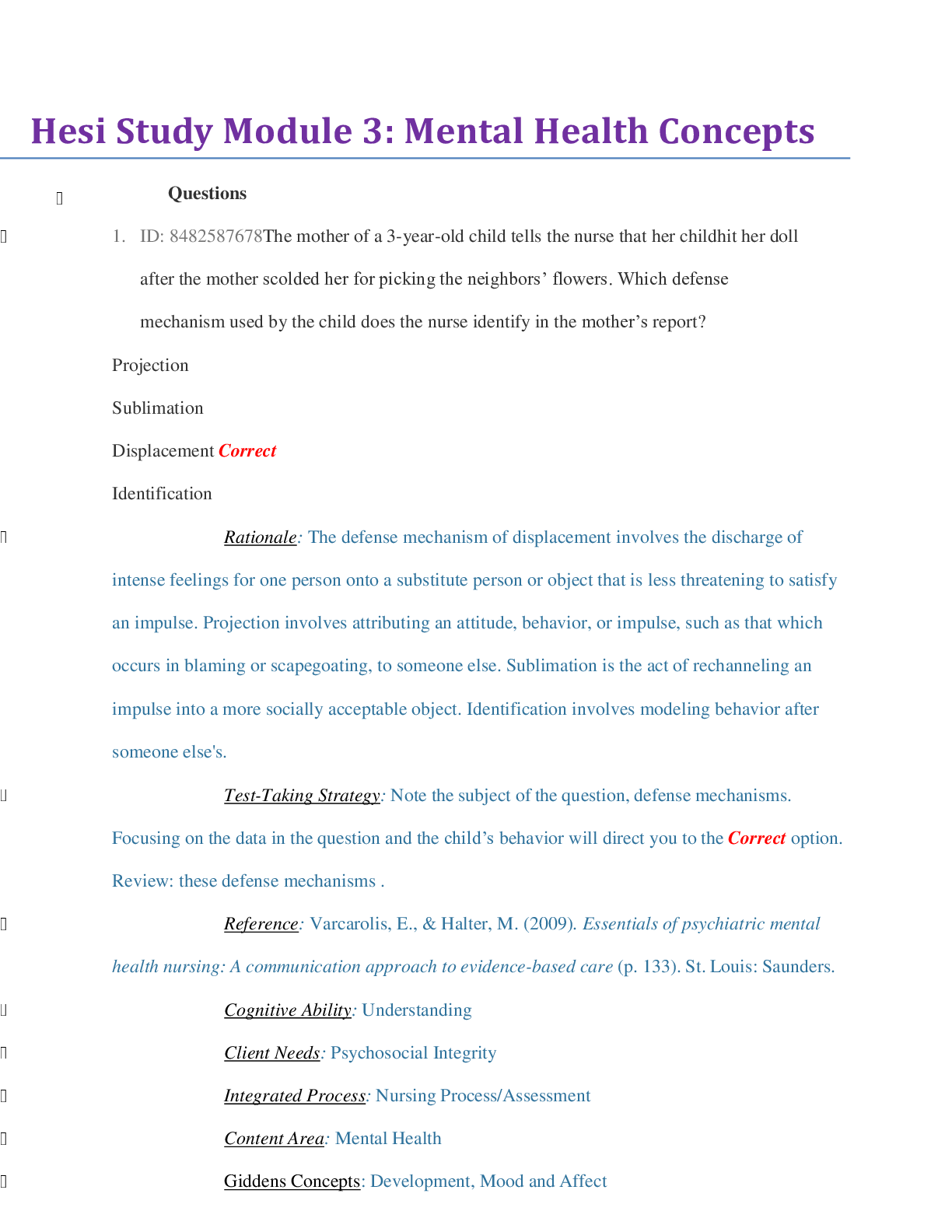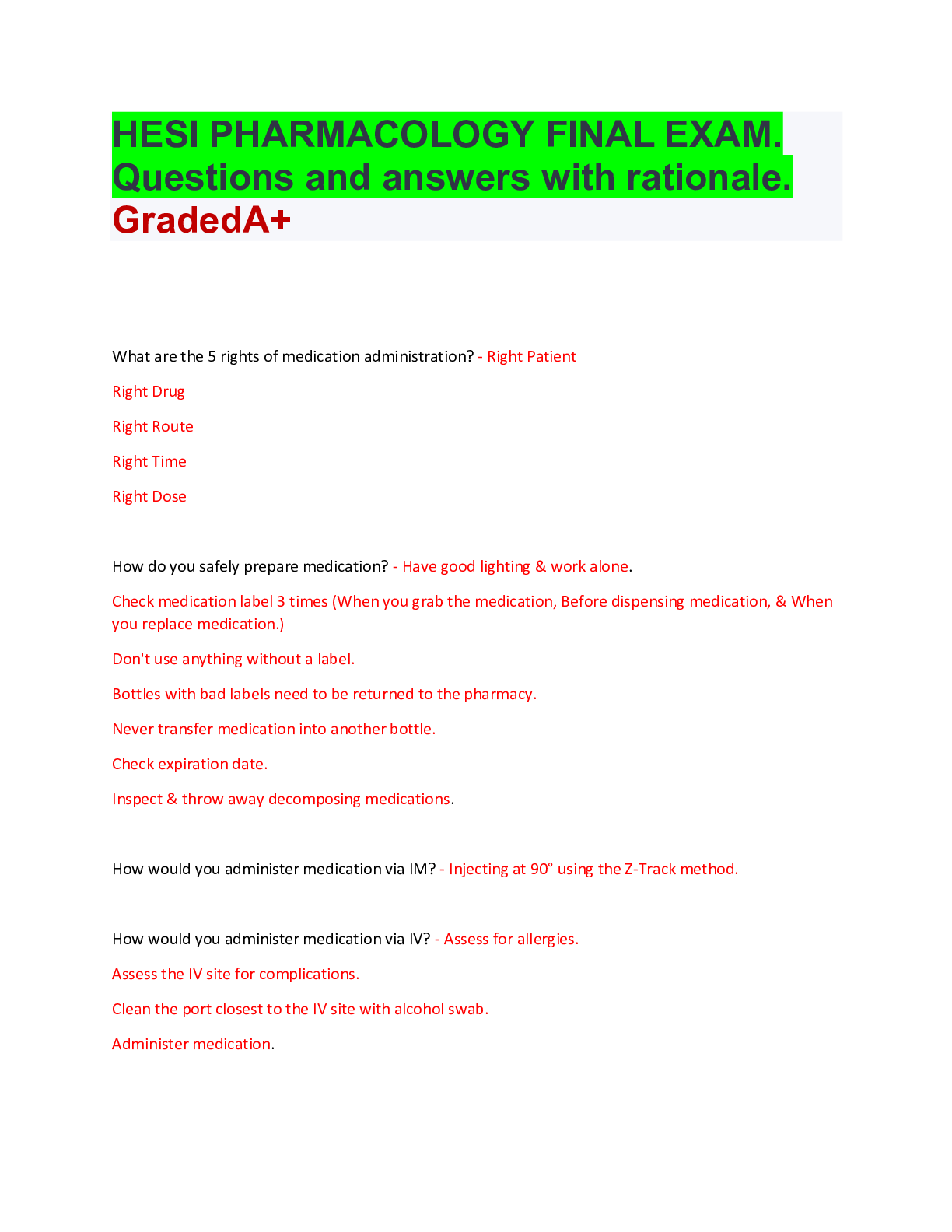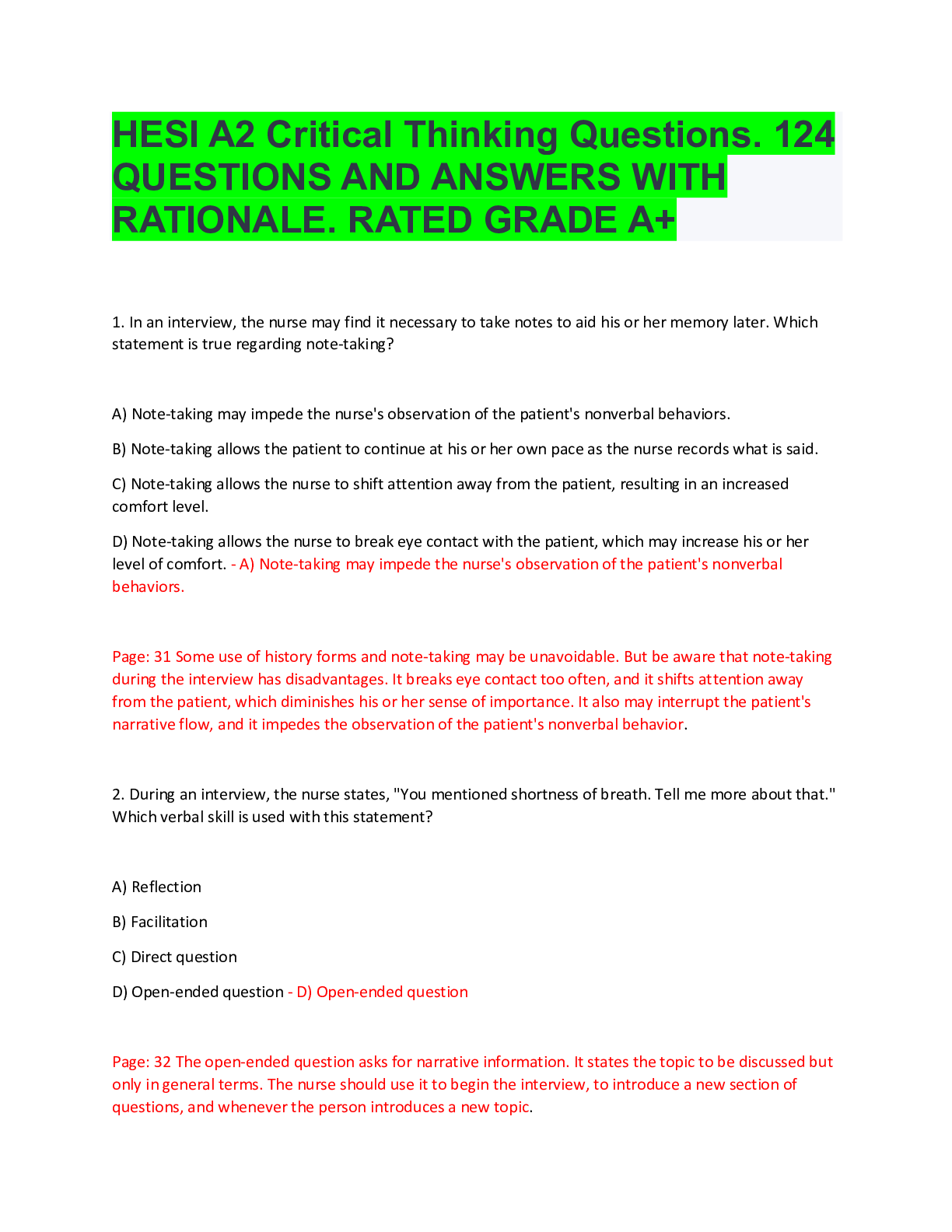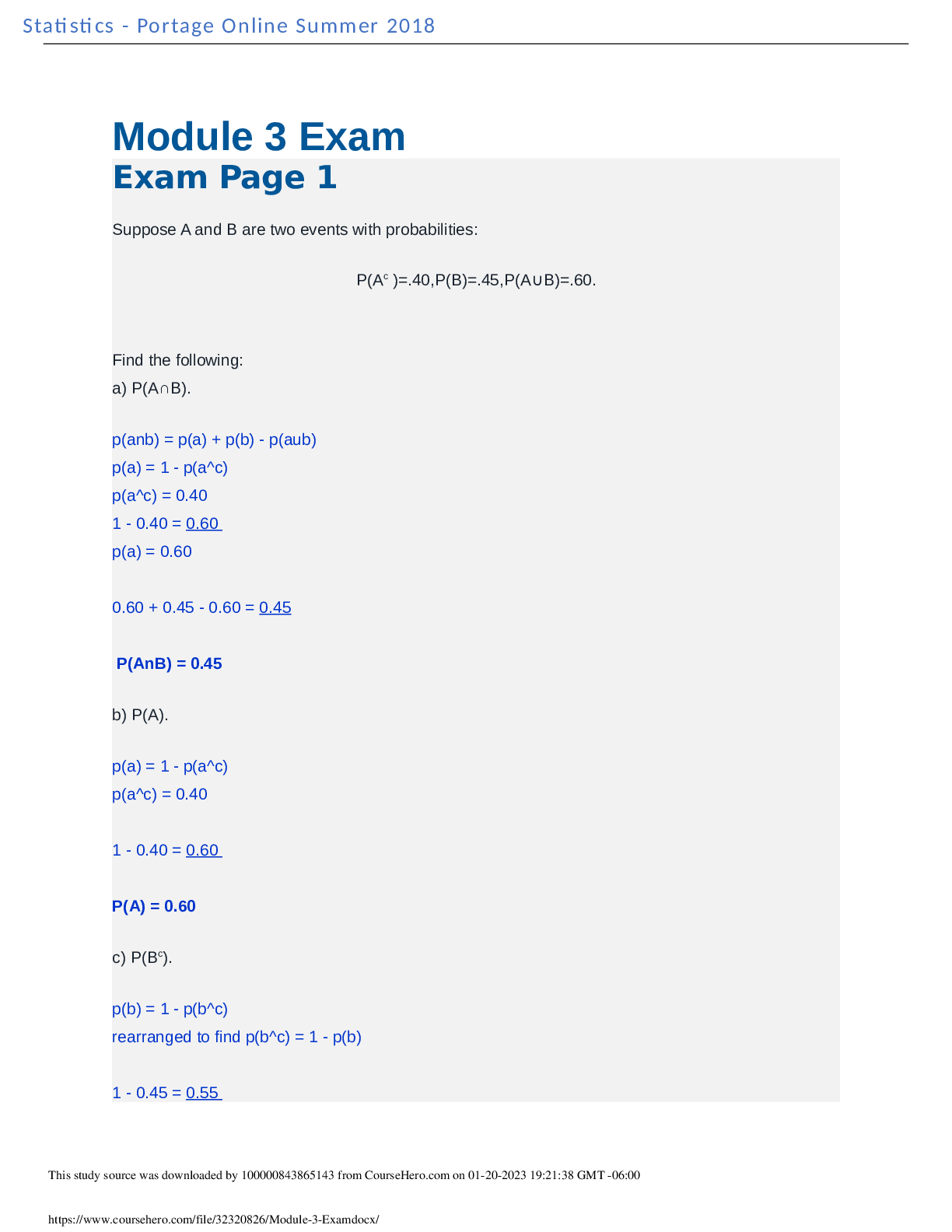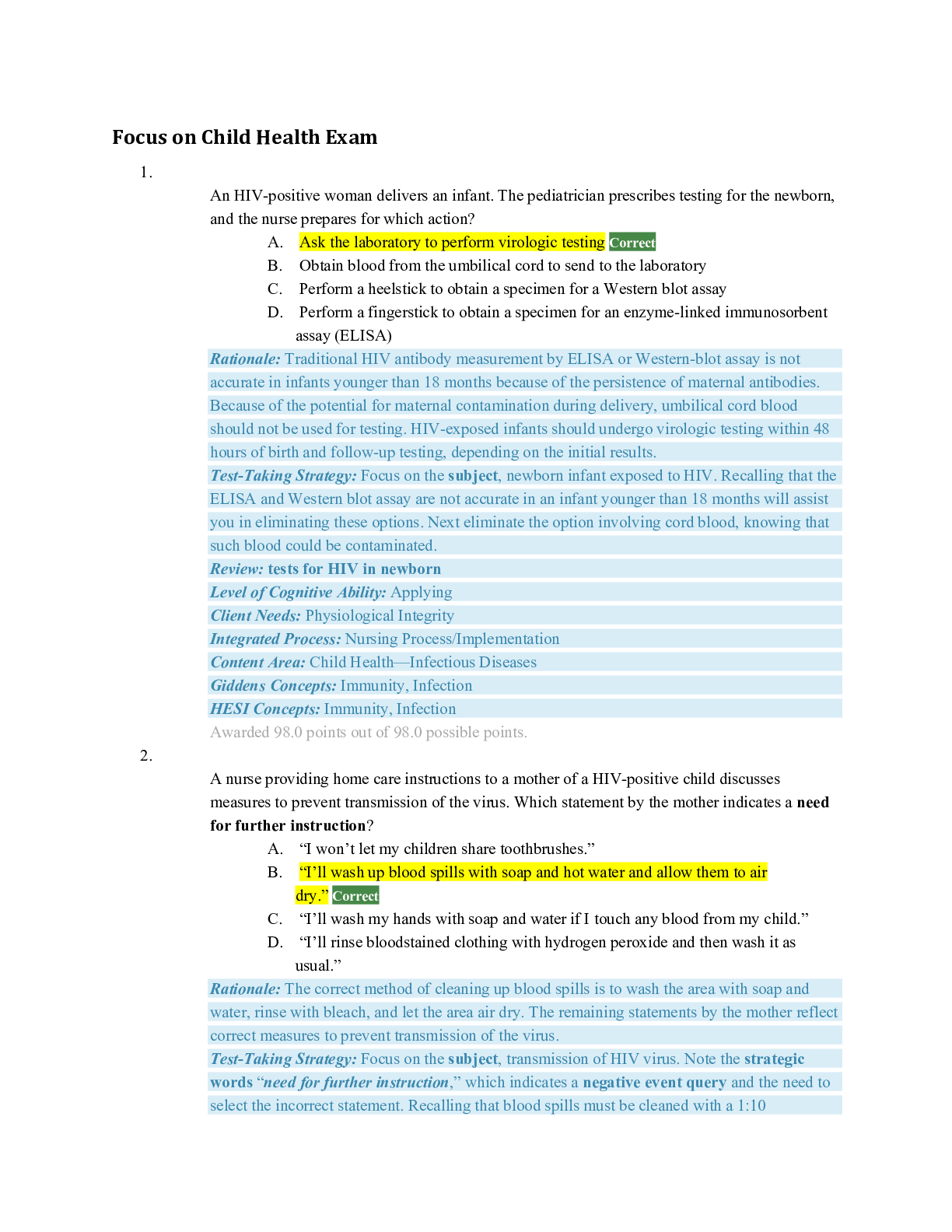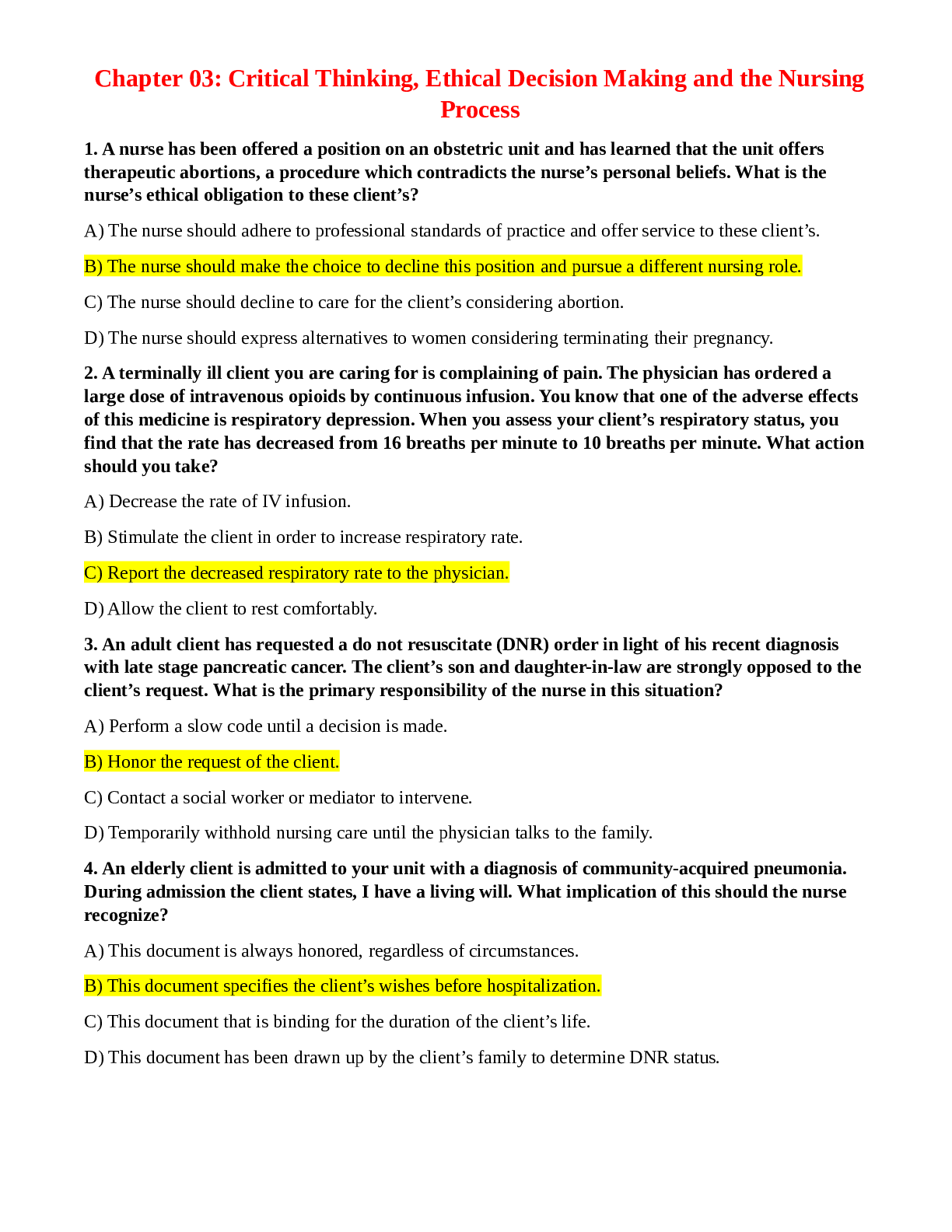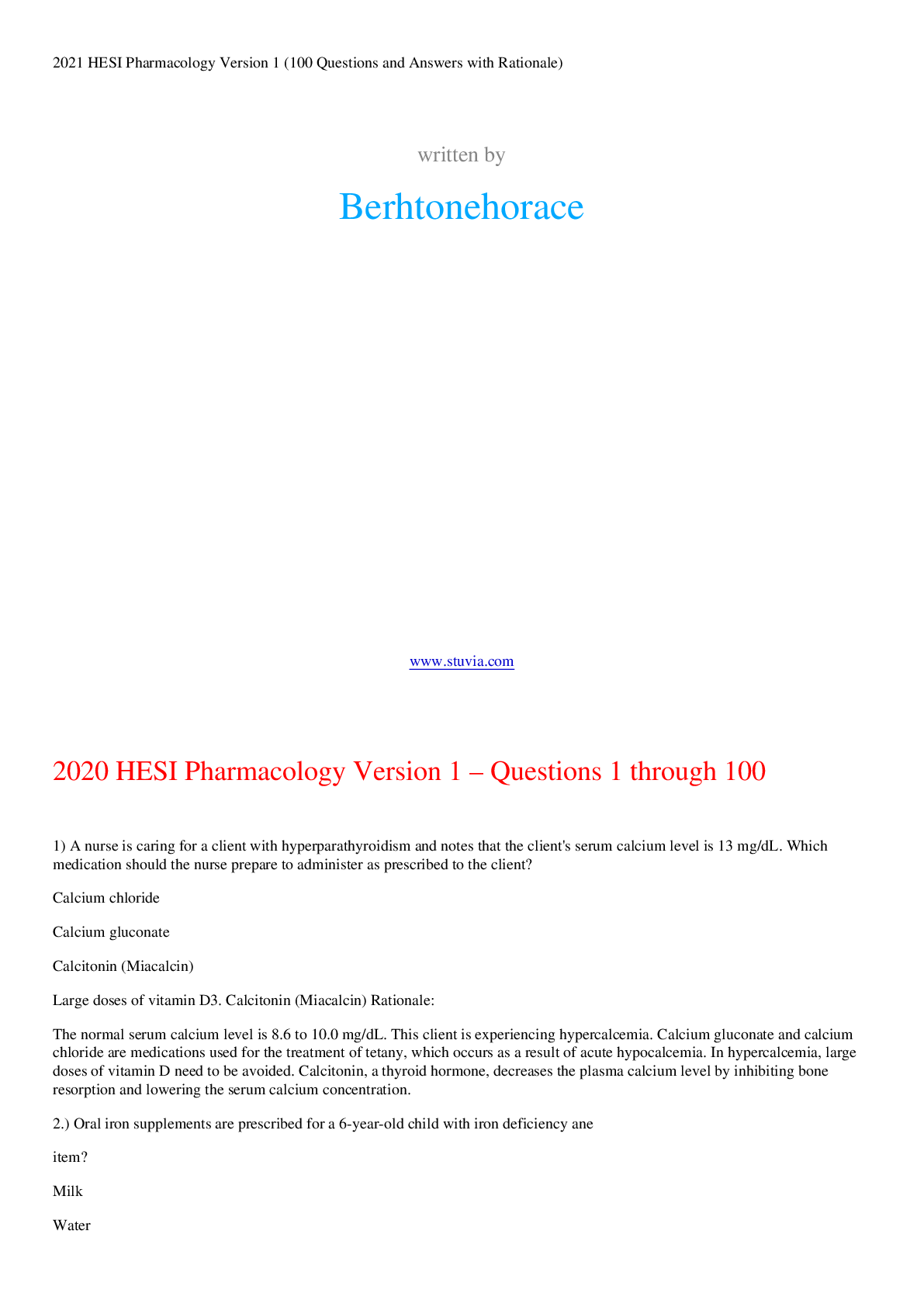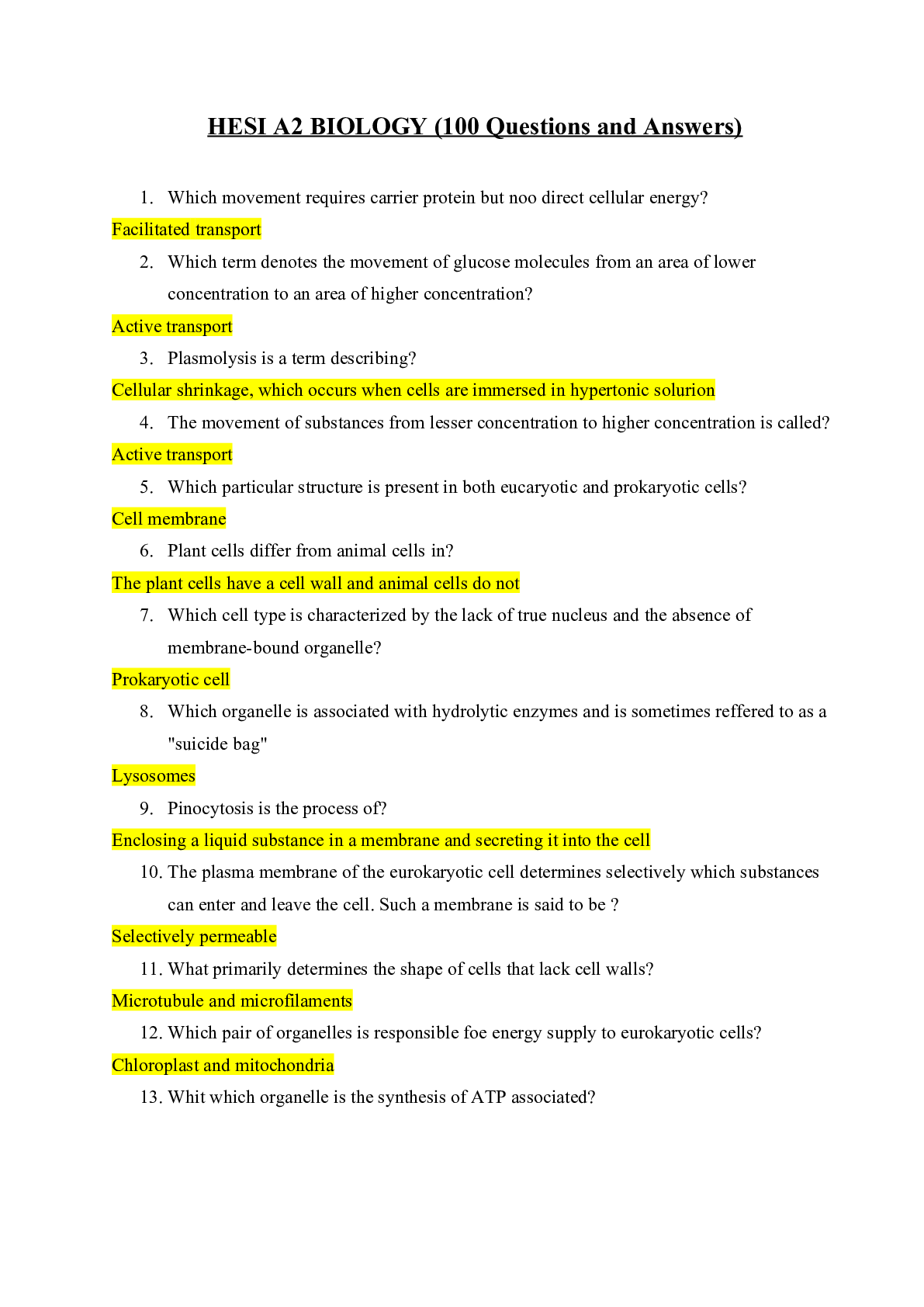*NURSING > HESI > HESI Review Advanced Medical-Surgical Nursing (Miami Dade College): 100 Questions and Answers with R (All)
HESI Review Advanced Medical-Surgical Nursing (Miami Dade College): 100 Questions and Answers with Rationale. Includes Test-Taking Strategy, Level of Cognitive Ability, Client Needs, Integrated Process, Content Area and the Reference,.
Document Content and Description Below
lOMoARcPSD|784381 Hesi Review Advanced Medical-Surgical Nursing (Miami Dade College) A client who has undergone abdominal surgery calls the nurse and reports that she just felt “something give... way” in the abdominal incision. The nurse checks the incision and notes the presence of wound dehiscence. The nurse immediately: Contacts the physician Incorrect Documents the findings Places the client in a supine position with the legs flat Covers the abdominal wound with a sterile dressing moistened with sterile saline solution Correct Level of Cognitive Ability: Applying Client Needs: Physiological Integrity Integrated Process: Nursing Process/Implementation Content Area: Perioperative Care Reference: Ignatavicius, D., & Workman, M. (2010). Medical-surgical nursing: Patient-centered collaborative care (6th ed., pp. 291, 292, 296). St. Louis: Saunders. A client who just returned from the recovery room after a tonsillectomy and adenoidectomy is restless and her pulse rate is increased. As the nurse continues the assessment, the client begins to vomit a copious amount of bright-red blood. The immediate nursing action is to: Notify the surgeon Correct Continue the assessment Check the client’s blood pressure Obtain a flashlight, gauze, and a curved hemostat Reference: Ignatavicius, D., & Workman, M. (2010). Medical-surgical nursing: Patient-centered collaborative care (6th ed., p. 657). St. Louis: Saunders. A client who has just undergone surgery suddenly experiences chest pain, dyspnea, and tachypnea. The nurse suspects that the client has a pulmonary embolism and immediately sets about: Preparing the client for a perfusion scan Attaching the client to a cardiac monitor Administering oxygen by way of nasal cannula Correct Ensuring that the intravenous (IV) line is patent Reference: Ignatavicius, D., & Workman, M. (2010). Medical-surgical nursing: Patient-centered collaborative care (6th ed., p. 680). St. Louis: Saunders. . 4.ID: 383738703 A nurse is assessing a client who has a closed chest tube drainage system. The nurse notes constant bubbling in the water seal chamber. What actions should the nurse take? (Select all that apply). Clamping the chest tube Changing the drainage system Assessing the system for an external air leak Correct Reducing the degree of suction being applied Documenting assessment findings, actions taken, and client response Correct A nurse is helping a client with a closed chest tube drainage system get out of bed and into a chair. During the transfer, the chest tube is caught on the leg of the chair and dislodged from the insertion site. The immediate priority on the part of the nurse is: Contacting the physician Reinserting the chest tube Transferring the client back to bed Covering the insertion site with a sterile occlusive dressing Correct A nurse performing nasopharyngeal suctioning and suddenly notes the presence of bloody secretions. The nurse would first: Continue suctioning to remove the blood Check the degree of suction being applied Correct Encourage the client to cough out the bloody secretions Remove the suction catheter from the client’s nose and begin vigorous suctioning through the mouth A nurse is suctioning a client through a tracheostomy tube. During the procedure, the client begins to cough, and the nurse hears a wheeze. The nurse tries to remove the suction catheter from the client’s trachea but is unable to do so. The nurse would first: Call a code Contact the physician Administer a bronchodilator Disconnect the suction source from the catheter Correct A nurse assesses the closed chest tube drainage system of a client who underwent lobectomy 24 hours ago. The nurse notes that there has been no chest tube drainage for the past hour. The nurse first: Contacts the physician Checks for kinks in the drainage system Correct Checks the client’s blood pressure and heart rate Connects a new drainage system to the client’s chest tube A nurse is assessing a postoperative client on an hourly basis. The nurse notes that the client’s urine output for the past hour was 25 mL. On the basis of this finding, the nurse first: Calls the physician Increases the rate of the IV infusion Checks the client’s overall intake and output record Correct Administers a 250-mL bolus of normal saline solution (0.9%) A nurse is getting a client out of bed for the first time since surgery. The nurse raises the head of the bed, and the client complains of dizziness. Which of the following actions should the nurse take first? Checking the client’s blood pressure Checking the oxygen saturation level Having the client take some deep breaths Lowering the head of the bed slowly until the dizziness is relieved Correct A nurse is preparing for intershift report when a nurse’s aide pulls an emergency call light in a client’s room. Upon answering the light, the nurse finds a client who returned from surgery earlier in the day experiencing tachycardia and tachypnea. The client’s blood pressure is 88/60 mm Hg. Which action should the nurse take first? Calling the physician Checking the hourly urine output Checking the IV site for infiltration Placing the client in a modified Trendelenburg position Correct A nurse is assessing the chest tube drainage system of a postoperative client who has undergone a right upper lobectomy. The closed drainage system contains 300 mL of bloody drainage, and the nurse notes intermittent bubbling in the water seal chamber. One hour after the initial assessment, the nurse notes that the bubbling in the water seal chamber is now constant, and the client appears dyspneic. On the basis of these findings, the nurse should first assess: The client’s vital signs The amount of drainage The client’s lung sounds The chest tube connections Correct A client recovering from surgery has a large abdominal wound. Which of the following foods, high in vitamin C, should the nurse encourage the client to eat as a means of promoting wound healing? Steak Veal Cheese Oranges Correct A nurse is caring for a client who has just regained bowel sounds after undergoing surgery. The physician has prescribed a clear liquid diet for the client. Which of the following items does the nurse ensure is available in the client’s room before allowing the client to drink? Straw Napkin Suction equipment Correct Oxygen saturation monitor A client in the postanesthesia care unit has an as-needed prescription for ondansetron (Zofran). Which of the following occurrences would prompt the nurse to administer this medication to the client? Paralytic ileus Incisional pain Urine retention Nausea and vomiting Correct A nurse administers scopolamine as prescribed to a client in preparation for surgery. For which side effect of this medication does the nurse monitor the client? Pupil constriction Increased urine output Complaints of dry mouth Correct Complaints of feeling sweaty A nurse is preparing a client for transfer to the operating room. Which of the following actions should the take in the care of this client at this time? Ensuring that the client has voided Correct Administering all daily medications Practicing postoperative breathing exercises Verifying that the client has not eaten for the last 24 hours A nurse receives a telephone call from a nurse on the post-anesthesia care unit, who reports that a client is being transferred to the surgical unit. What should the nurse plan to do first on arrival of the client? Assess the patency of the airway Correct Check tubes and drains for patency Check the dressing for bleeding Assess the vital signs to compare them with preoperative measurements A client without a history of respiratory disease has a pulse oximeter in place after surgery. The nurse monitors the pulse oximeter readings to ensure that oxygen saturation remains above: 85% 89% 95% Correct 100% Rationale: Pulse oximetry is a noninvasive method of continuously monitoring the oxygen saturation of hemoglobin (SaO2). In the absence of underlying respiratory disease, the expected reading is at least 95%. Therefore the other options are incorrect. Readings of 85% and 89% are lower than what is desired in the postoperative period. A level of 100% is most desirable, but the level should remain at least 95% A client who underwent preadmission testing 1 week before surgery had blood drawn for several serum laboratory studies. Which abnormal laboratory results should the nurse report to the surgeon’s office? Select all that apply. Hematocrit 30% Correct Sodium 141 mEq/L Hemoglobin 8.9 g/dL Correct Platelets 210,000 cells/mm3 Serum creatinine 0.8 mg/dL A client has been scheduled for magnetic resonance imaging (MRI). For which of the following conditions, a contraindication to MRI, does the nurse check the client’s medical history? Pancreatitis Pacemaker insertion Correct Type 1 diabetes mellitus Chronic airway limitation A client has just undergone lumbar puncture. Into which position does the nurse assist the client after the procedure? Flat Correct Semi-Fowler Side-lying, with the head of the bed elevated Sitting up in a recliner with the feet elevated A client has just returned to the nursing unit after computerized tomography (CT) with contrast medium. Which of the following actions should the nurse plan to take as part of routine after-care for this client? Administering a laxative Encouraging fluid intake Correct Maintaining the client on strict bed rest Holding all medications for at least 2 hours A client reports for a scheduled electroencephalogram (EEG). Which statement by the client indicates a need for additional preparation for the test? “I didn’t shampoo my hair.” Correct “I ate breakfast this morning.” “I didn’t take my anticonvulsant today.” “It was hard not to drink coffee this morning, but I knew that I couldn’t, so I didn’t.” Blood is drawn from a client with suspected uric acid calculi for a serum uric acid determination. Which value does the nurse recognize as a normal uric acid level? 1.7 mg/dL 5.8 mg/dL Correct 8.9 mg/dL 12.8 mg/dL A nurse is providing post-procedure instructions to a client returning home after arthroscopy of the shoulder. The nurse should tell the client: To resume full activity the next day Not to eat or drink anything until the next morning To keep the shoulder completely immobilized for the rest of the day To report to the physician the development of fever or redness and heat at the site Correct A client is tested for HIV with the use of an enzyme-linked immunosorbent assay (ELISA), and the test result is positive. The nurse should tell the client that: HIV infection has been confirmed The client probably has an opportunistic infection The test will need to be confirmed with the use of a Western blot Correct A positive test is a normal result and does not mean that the client is infected with HIV A CD4+ lymphocyte count is performed on a client who is infected with HIV. The results of the test indicate a CD4+ count of 450 cells/L. The nurse interprets this test result as indicating: Improvement in the client The need for antiretroviral therapy Correct The need to discontinue antiretroviral therapy An effective response to the treatment for HIV A client has just undergone a renal biopsy. Which intervention should the nurse include intervention in the post-procedure plan of care? Restricting fluid intake for the first 24 hours Periodically testing the urine for occult blood Correct Avoiding the administration of opioid analgesics Having the client ambulate in the room and hall for short distances A nurse has a prescription to collect a 24-hour urine specimen from a client. Which of the following measures should the nurse take during this procedure? Keeping the specimen at room temperature Saving the first urine specimen collected at the start time Discarding the last voided specimen at the end of the collection time Asking the client to void, discarding the specimen, and noting the start time Correct Administering a sedative Encouraging fluid intake Administering an oral preparation of radiopaque dye Questioning the client about allergies to iodine or shellfish Correct A client who has undergone renal biopsy complains of pain, radiating to the front of the abdomen, at the biopsy site. For which of the following findings should the nurse assess the client? Bleeding Correct Renal colic Infection at the site Increased temperature A client has undergone renal angiography by way of the right femoral artery. The nurse determines that the client is experiencing a complication of the procedure on noting: Urine output of 40 mL/hr Blood pressure of 118/76 mm Hg Respiratory rate of 18 breaths/min Pallor and coolness of the right leg Correct A nurse reviews a client’s urinalysis report. Which finding does the nurse recognize as abnormal? pH of 6.0 An absence of protein The presence of ketones Correct Specific gravity of 1.018 A nurse provides information to a client who is scheduled for cardiac catheterization to rule out coronary occlusion. The nurse should tell the client that: The procedure is performed in the operating room It is necessary to lie quietly on a hard x-ray table for about 4 hours The room is bright and well lit, and it is best to keep the eyes closed The client may have feelings of warmth or flushing during the procedure Correct A client who has sustained a myocardial infarction is scheduled to have an echocardiogram. Which of the following measures should the nurse take before the procedure? Imposing nothing-by-mouth (NPO) status for 4 hours Asking the client to sign an informed consent form Asking the client about a history of allergy to iodine or shellfish Telling the client that the procedure is painless and takes 30 to 60 minutes to complete Correct A nurse in a physician’s office has just made an appointment for a client to undergo an exercise stress test. The nurse, in providing pre-procedure teaching, should tell the client to: Wear sweatpants and a heavy sweatshirt Eat a small meal just before the procedure Wear comfortable rubber-soled shoes such as sneakers Correct Avoid consuming caffeine for 30 minutes before the procedure A nurse has a prescription to apply a Holter monitor to a client for continuous cardiac monitoring for a 24-hour period. What steps should the nurse take to initiate this prescription? Select all that apply. Giving the client a device holder to wear around the waist Correct Giving the client a diary in which to record all activity and symptoms Correct Telling the client to rest as much as possible during the next 24 hours Instructing the client to enclose the monitor in plastic wrap before taking a bath Telling the client that occasional slight shocks from the monitor will be felt but that they are harmless A client has undergone pericardiocentesis to treat cardiac tamponade. For which signs should the nurse assess the client to determine whether the tamponade is recurring? Decreasing pulse Rising blood pressure Distant muffled heart sounds Correct Falling central venous pressure (CVP) A nurse is watching as a nursing assistant measures the blood pressure (BP) of a hypertensive client. Which actions on the part of the assistant that would interfere with accurate measurement would prompt the nurse to intervene? Select all that apply. Measuring the BP after the client has sat quietly for 5 minutes Having the client sit with the arm bared and supported at heart level Used a cuff with a rubber bladder that encircles at least 60% of the limb Correct Measuring the BP after the client reports that he just drank a cup of coffee Correct Allowing the client to talk as the blood pressure is being measured Correct A nurse is watching as a nursing student suctions a client through a tracheostomy tube. Which actions on the part of the student would prompt the nurse to intervene and demonstrate correct procedure? Select all that apply. Setting the suction pressure to 60 mm Hg Correct Applying suction throughout the procedure Correct Assessing breath sounds before suctioning Placing the client in a supine position before the procedure Correct Hyperoxygenating the client with 100% oxygen before suctioning Oxygen by way of nasal cannula has been prescribed for a client with emphysema. The nurse checks the physician’s prescriptions to ensure that the prescribed flow is not greater than: 1 L/min 3 L/min Correct 4 L/min 6 L/min A client who experienced the sudden onset of respiratory distress has been intubated with an endotracheal tube. Immediately after the tube is placed in the trachea, the nurse should: Tape the tube in place Send the client for a chest x-ray Note how far the tube has been inserted Auscultate both lungs for the presence of breath sounds Correct A client has a chest drainage system in place. The fluid in the water seal chamber rises and falls during inspiration and expiration. The nurse interprets this finding as an indication that: The tube is patent Correct There is probably a kink in the tubing Suction should be added to the system The client is retaining airway secretions A nurse is performing nasotracheal suctioning on a client. Which of the following observations should be cause for concern to the nurse? Select all that apply. The client becomes cyanotic. Correct Secretions are becoming bloody. Correct The client gags during the procedure. Clear to opaque secretions are removed. The heart rate varies from 80 to 82 beats/min. A nurse is monitoring the respiratory status of a client who has just undergone surgery and is wearing a pulse oximeter. Which of the following coexisting problems is cause for the nurse to suspect that the oxygen saturation readings are not entirely accurate? Infection Hypertension Low blood pressure Correct Loss of cough reflex A nurse is reading the radiology report of a client with a chest tube attached to a closed drainage system who has undergone a chest x-ray. The report states that the client’s affected lung is fully reexpanded. The nurse anticipates that the next assessment of the chest tube system will reveal: No fluctuation in the water seal chamber Correct Continuous bubbling in the water seal chamber Increased drainage in the collection chamber Continuous gentle suction in the suction control chamber A client has just undergone insertion of a chest tube that is attached to a closed chest drainage system. Which action should the nurse plan to take in the care of this client? Assessing the client’s chest for crepitus once every 24 hours Taping the connections between the chest tube and the drainage system Correct Adding 20 mL of sterile water to the suction control chamber every shift Recording the volume of secretions in the drainage collection chamber every 24 hours A client who has just undergone bronchoscopy was returned to the nursing unit 1 hour ago. With which assessment finding is the nurse most concerned? Oxygen saturation of 97% Equal breath sounds in both lungs Absence of cough and gag reflexes Correct Respiratory rate of 20 breaths/min A nurse is caring for a client who has undergone pulmonary angiography with catheter insertion through the right femoral vein. The nurse assesses for allergic reaction to the contrast medium by monitoring for the presence of: Bradycardia Respiratory distress Correct Hematoma in the right groin Discomfort in the right groin A nurse is conducting an assessment of a client who underwent thoracentesis of the right side of the chest 3 hours ago. Which findings does the nurse report to the physician? Select all that apply. Unequal chest expansion Correct Pulse rate of 82 beats/min Respiratory rate of 22 breaths/min Diminished breath sounds in the right lung Correct Complaints of discomfort at the needle insertion site A nurse is monitoring a client who has undergone pleural biopsy. Which of the following findings causes the nurse to suspect that the client is experiencing a complication? Warm, dry skin Mild pain at the biopsy site Complaints of shortness of breath Correct Capillary refill time of less than 3 seconds A client has just returned to the nursing unit after bronchoscopy. To which intervention should the nurse give priority? Ambulating the client Administering pain medication Encouraging copious fluid intake Checking for the return of the gag reflex Correct A client is receiving intermittent bolus feedings by way of a nasogastric tube. In which position should the nurse place the client once the feeding is complete? Supine Head of bed flat Left lateral position Head of bed elevated 30 to 45 degrees Correct A nurse has a prescription to discontinue a client’s nasogastric tube. The nurse auscultates the client’s bowel sounds, positions the client properly, and flushes the tube with 15 mL of air to clear secretions. The nurse then instructs the client to take a deep breath and: Exhale during tube removal Bear down during tube removal Hold the breath during tube removal Correct Breathe normally during tube removal A nurse checks the residual volume from a client’s nasogastric tube feeding before administering an intermittent tube feeding and finds 35 mL of gastric contents. What should the nurse do before administering the prescribed 100 mL of formula to the client? Pour the residual volume into the nasogastric tube through a syringe with the plunger removed Correct Discard the residual volume properly and record it as output on the client’s fluid balance record Dilute the residual volume with water and inject it into the nasogastric tube, applying pressure on the plunger Mix the residual volume with the formula and pour it into the nasogastric tube, using a syringe without a plunger A nurse has a prescription to insert a nasogastric tube into the stomach of an assigned client. Which action should the nurse take to insert the tube safely and easily? Placing the tube in warm water Hyperextending the head while inserting the tube Removing the tube if any resistance to insertion is met Asking the client to swallow as the tube is being advanced Correct A client who has undergone an esophagogastroduodenoscopy (EGD) returns from the endoscopy department. After checking the client’s gag reflex, which action should the nurse take? Taking the client’s vital signs Correct Giving the client a drink of water Monitoring the client for a sore throat Being alert to complaints of heartburn A client has just been scheduled for endoscopic retrograde cholangiopancreatography (ERCP). What should the nurse tell the client about the procedure? Select all that apply. That informed consent is required Correct That the test takes about 4 hours to complete That no premedication for sedation will be necessary That food and fluids will be withheld before the procedure Correct That multiple position changes may be necessary to pass the tube Correct A client is scheduled for a barium swallow (esophagography) in 2 days. The nurse, providing preprocedure instructions, should tell the client to: Eat a regular supper and breakfast Remove all metal and jewelry before the test Correct Expect diarrhea for a few days after the procedure Take all oral medications as scheduled with milk on the day of the test A nurse is preparing a client for colonoscopy. Into which position does the nurse assist the client for the procedure? Left Sims’ position Correct Lithotomy position Knee-chest position Right Sims’ position Polyethylene glycol–electrolyte solution (GoLYTELY) is prescribed for a hospitalized client scheduled for colonoscopy. The client begins to experience diarrhea after drinking the solution. Which action by the nurse is appropriate? Calling the physician Administering a cleansing enema Documenting the diarrhea in the medical record Correct Giving intravenous replacement fluids in large amounts A physician is about to perform paracentesis on a client with abdominal ascites. Into which position would the nurse assist the client? Supine Upright Correct Left side–lying Right side–lying A nurse is reviewing the results of serum laboratory studies of a client with suspected hepatitis. Which increased parameter is interpreted by the nurse as the most specific indicator of this disease? Hemoglobin Serum bilirubin Correct Blood urea nitrogen (BUN) Erythrocyte sedimentation rate (ESR) A nurse is preparing to examine a client’s skin using a Wood light. What should the nurse do to facilitate this procedure? Darken the examining room Correct Administer a local anesthetic Obtain a signed informed consent Shave the skin and scrub it with povidone-iodine (Betadine) A nurse is assessing the status of a client with diabetes mellitus. The nurse concludes that the client is exhibiting adequate diabetic control if the serum level of glycosylated hemoglobin A1C (HbA1C) is less than: 7% Correct 9% 10% 15% A client with diabetes mellitus is scheduled to have blood drawn for a fasting blood glucose determination drawn in the morning. What does the nurse tell the client that it is acceptable to consume on the morning of the test? Water Correct Tea without any sugar Coffee without any milk Clear liquids such as apple juice A client is scheduled to undergo computerized tomography (CT) with contrast for evaluation of an abdominal mass. The nurse should tell the client that: The test may be painful The test takes 2 to 3 hours Food and fluids are not allowed for 4 hours after the test Dye is injected and may cause a warm flushing sensation Correct Rationale: A contrast-aided CT scan involves the injection of dye to enhance the images that are obtained. The dye may cause a warm flushing sensation when it is injected. If an iodine dye is used, the client should be asked about allergies to seafood or iodine. The CT scan, which causes no pain, generally lasts between 15 and 60 minutes. Fluids are encouraged after the procedure to help eliminate dye by way of the kidneys. A pelvic ultrasound is prescribed to evaluate a client’s ovarian mass. What should the nurse giving preprocedure instructions tell the client that it important to do before the procedure? Eat only a light breakfast Wear comfortable clothing and shoes Drink 6 to 8 glasses of water without voiding Correct Stop eating or drinking at midnight before the test A client has been given a diagnosis of multiple myeloma. Which of the following results does the nurse reviewing the client’s laboratory findings recognize as being specifically related to this diagnosis? Increased calcium level Correct Increased white blood cell (WBC) count Decreased blood urea nitrogen (BUN) Decreased number of plasma cells in the bone marrow A woman has been scheduled for a routine mammogram. The nurse should tell the client: That mammography takes about 1 hour Not to eat or drink on the morning of the test That there is no discomfort associated with the procedure That deodorants, powders, or creams used in the axillary or breast area must be washed off before the test Correct . A client has made an appointment to for her annual Papanicolaou test (a.k.a. Pap smear). The nurse who schedules the appointment should tell the client that: The test cannot be performed while the client is menstruating Correct Vaginal douching is required an hour before the test Spicy foods should not be eaten on the day of the test The test has absolutely no discomfort associated with it A client who has just undergone a skin biopsy is listening to discharge instructions from the nurse. The nurse determines that the client has misunderstood the directions if the client indicates that as part of aftercare he plans to: Use the antibiotic ointment as prescribed Return in 7 days to have the sutures removed Apply cool compresses to the site twice a day for 20 minutes Correct Call the physician if excessive drainage from the wound occurs A serum phenytoin determination is prescribed for a client with a seizure disorder who is taking phenytoin (Dilantin). Which result indicates that the prescribed dose of phenytoin is therapeutic? 3 mcg/mL 8 mcg/mL 16 mcg/mL Correct 28 mcg/mL A client is receiving a continuous IV infusion of heparin for the treatment of deep vein thrombosis. The client’s activated partial thromboplastin time (aPTT) level is 80 seconds. The client’s baseline before the initiation of therapy was 30 seconds. Which action does the nurse anticipate is needed? Shutting off the heparin infusion Increasing the rate of the heparin infusion Decreasing the rate of the heparin infusion Correct Leaving the rate of the heparin infusion as is A client with cardiovascular disease is scheduled to receive a daily dose of furosemide (Lasix). Which potassium level would cause the nurse, reviewing the client’s electrolyte values, to contact the physician before administering the dose? 3.0 mEq/L Correct 3.8 mEq/L 4.2 mEq/L 5.1 mEq/L A young adult asks the nurse about the normal cholesterol level. The nurse tells the client that the total cholesterol level should be maintained at less than: 140 mg/dL 200 mg/dL Correct 250 mg/dL 300 mg/dL A nurse is reviewing the results of renal function testing in a client with renal calculi. Which finding indicates to the nurse that the client’s blood urea nitrogen (BUN) level is within the normal range? 2 mg/dL 18 mg/dL Correct 25 mg/dL 35 mg/dL An adult female client has undergone a routine health screening in the clinic. Which of the following values indicates to the nurse who receives the report of the client’s laboratory work that the client’s hematocrit is normal? 10% 22% 30% 43% Correct A client admitted to the hospital with a diagnosis of acute pancreatitis has blood drawn for several serum laboratory tests. Which of the following serum amylase values, noted by the nurse reviewing the results, would be expected in this client at this time? 48 units/L 97 units/L 150 units/L 395 units/L Correct A nurse is reviewing laboratory results for a client who is at risk for nephrotoxicity because of medications he is taking. Which of the following serum creatinine results does the nurse document as normal? 0.2 mg/dL 1.0 mg/dL Correct 2.8 mg/dL 3.9 mg/dL A client with type 1 diabetes mellitus has a blood glucose level of 620 mg/dL. After the nurse calls the physician to report the finding and monitors the client closely for: Metabolic acidosis Correct Metabolic alkalosis Respiratory acidosis Respiratory alkalosis A nurse reviews the blood gas results of a client in respiratory distress. The pH is 7.32 and the PCO2 is 50 mm Hg. Which of the following acid-base imbalances does the nurse recognize in these findings? Metabolic acidosis Metabolic alkalosis Respiratory acidosis Correct Respiratory alkalosis Blood for arterial blood gas determinations is drawn on a client with pneumonia, and testing reveals a pH of 7.45, PCO2 of 30 mm Hg, and HCO3 of 19 mEq/L. The nurse interprets these results as indicative of: Compensated metabolic acidosis Compensated respiratory alkalosis Correct Uncompensated metabolic alkalosis Uncompensated respiratory acidosis A nurse is caring for a client who is vomiting. For which acid-base imbalance does the nurse assess the client? Metabolic acidosis Metabolic alkalosis Correct Respiratory acidosis Respiratory alkalosis A nurse is caring for a client with diarrhea. For which acid-base disorder does the nurse assess the client? Metabolic acidosis Correct Metabolic alkalosis Respiratory acidosis Respiratory alkalosis A client tells the nurse that he has been experiencing frequent heartburn and has been “living on antacids.” For which acid-base disturbance does the nurse recognize a risk? Metabolic acidosis Metabolic alkalosis Correct Respiratory acidosis Respiratory alkalosis A client has the following arterial blood gas (ABG) results: pH 7.51, PCO2 31 mm Hg, PO2 94 mm Hg, HCO3 24 mEq/L. Which of the following acid-base disturbances does the nurse recognize in these results? Metabolic acidosis Metabolic alkalosis Respiratory acidosis Respiratory alkalosis Correct . A client with histoplasmosis has the following arterial blood gas (ABG) results: pH 7.30, PCO2 58 mm Hg, PO2 75 mm Hg, HCO3 27 mEq/L. Which of the following acid-base disturbances does the nurse recognize in these results? Metabolic acidosis Metabolic alkalosis Respiratory acidosis Correct Respiratory alkalosis A client is brought to the emergency department by a neighbor. The client is lethargic and has a fruity odor on the breath. The client’s arterial blood gas (ABG) results are pH 7.25, PCO2 34 mm Hg, PO2 86 mm Hg, HCO3 14 mEq/L. Which of the following acid-base disturbances does the nurse recognize in these results? Metabolic acidosis Correct Metabolic alkalosis Respiratory acidosis Respiratory alkalosis A client who is anxious about an impending surgery is at risk for respiratory alkalosis. For which signs and symptoms of respiratory alkalosis does the nurse assess this client? Disorientation and dyspnea Drowsiness, headache, and tachypnea Tachypnea, dizziness, and paresthesias Correct Dysrhythmias and decreased respiratory rate and depth A client with a history of lung disease is at risk for respiratory acidosis. For which of the following signs and symptoms does the nurse assess this client? Disorientation and dyspnea Correct Drowsiness, headache, and tachypnea Tachypnea, dizziness, and paresthesias Dysrhythmias and decreased respiratory rate and depth A client who has received sodium bicarbonate in large amounts is at risk for metabolic alkalosis. For which of the following signs and symptoms does the nurse assess this client? Disorientation and dyspnea Drowsiness, headache, and tachypnea Tachypnea, dizziness, and paresthesias Dysrhythmias and decreased respiratory rate and depth Correct A client who is mouth breathing is receiving oxygen by face mask. The nursing assistant asks the nurse why a water bottle is attached to the oxygen tubing near the wall oxygen outlet. The nurse responds that the primary purpose of the water is to: Prevent the client from getting a nosebleed Give the client added fluid by way of the respiratory tree Humidify the oxygen that is bypassing the client’s nose Correct Prevent fluid loss from the lungs during mouth breathing A client’s baseline vital signs are temperature 98° F oral, pulse 74 beats/min, respiratory rate 18 breaths/min, and blood pressure 124/76 mm Hg. The client suddenly spikes a fever of 103° F. Which of the following respiratory rates would the nurse anticipate as part of the body’s response to the change in client status? 12 breaths/min 16 breaths/min 18 breaths/min 22 breaths/min Correct A client with chronic obstructive pulmonary disease (COPD) who is beginning oxygen therapy asks the nurse why the flow rate cannot be increased to more than 2 L/min. The nurse responds that this would be harmful because it could: Be drying to nasal passages Decrease the client’s oxygen-based respiratory drive Correct Increase the risk of pneumonia as a result of drier air passages Decrease the client’s carbon dioxide–based respiratory drive A nurse is reading the chest x-ray report of a client who has just been intubated. The report states that the tip of the endotracheal tube lies 1 cm above the carina. The nurse interprets that the tube is positioned above: The first tracheal cartilaginous ring The point where the larynx connects to the trachea The bifurcation of the right and left main stem bronchi Correct The area connecting the oropharynx to the laryngopharynx . A nurse is caring for a client who has lost a significant amount of blood as a result of complications during a surgical procedure. Which parameter does the nurse recognize as the earliest indication of new decreases in fluid volume? Pulse rate Correct Blood pressure Pulmonary artery systolic pressure Pulmonary artery end-diastolic pressure A nurse is admitting a client with a diagnosis of hypothermia to the hospital. Which of the following signs does the nurse anticipate that this client will exhibit? Increased heart rate and increased blood pressure Increased heart rate and decreased blood pressure Decreased heart rate and increased blood pressure Decreased heart rate and decreased blood pressure Correct A nurse is teaching a nursing student how to measure a carotid pulse. The nurse should tell the student to measure the pulse on only one side of the client’s neck primarily because: It is unnecessary to use both hands Feeling dual pulsations may lead to an incorrect measurement Palpating both carotid pulses simultaneously could occlude the trachea Palpating both carotid pulses simultaneously could cause the heart rate and blood pressure to drop Correct . [Show More]
Last updated: 1 year ago
Preview 1 out of 89 pages
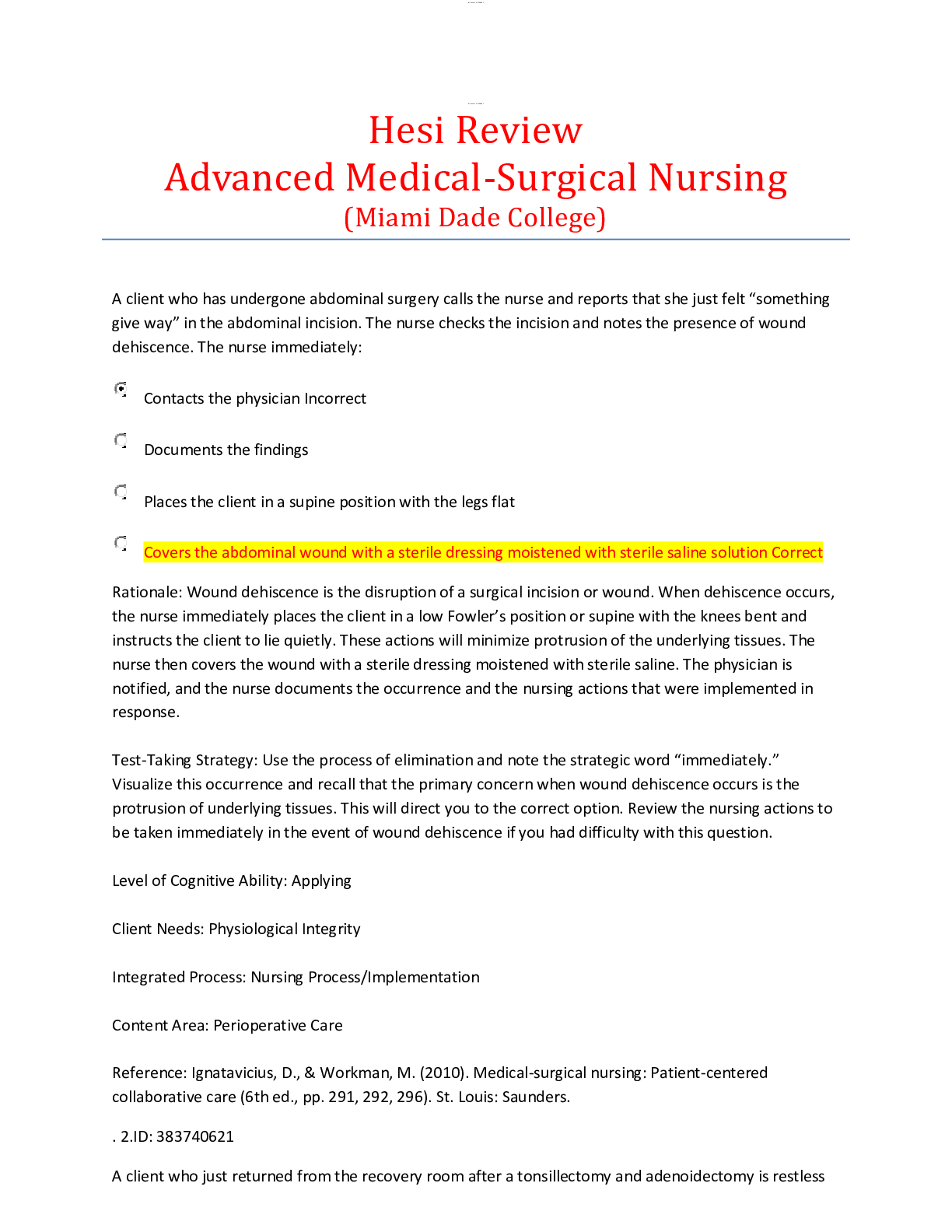
Reviews( 0 )
Document information
Connected school, study & course
About the document
Uploaded On
Sep 01, 2020
Number of pages
89
Written in
Additional information
This document has been written for:
Uploaded
Sep 01, 2020
Downloads
0
Views
283


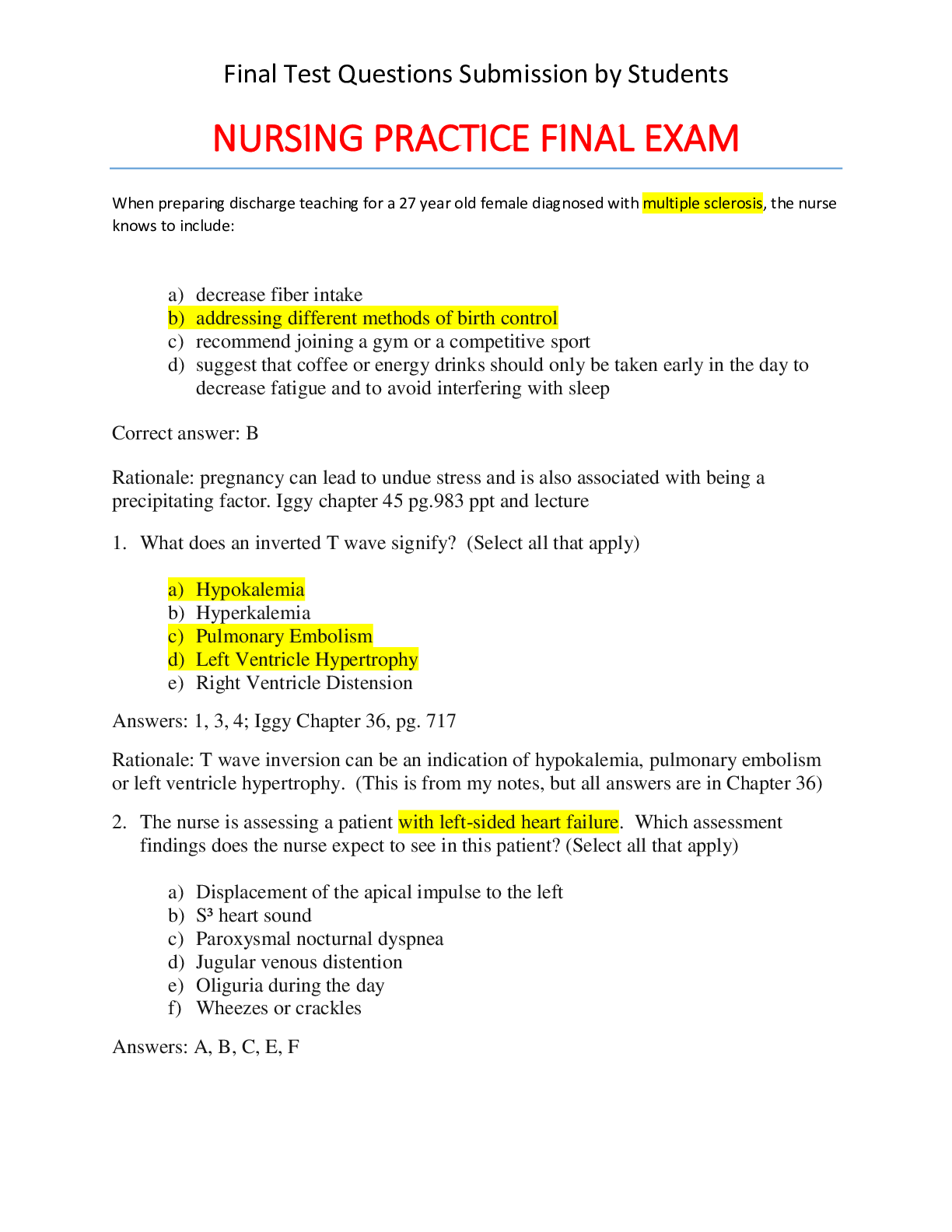
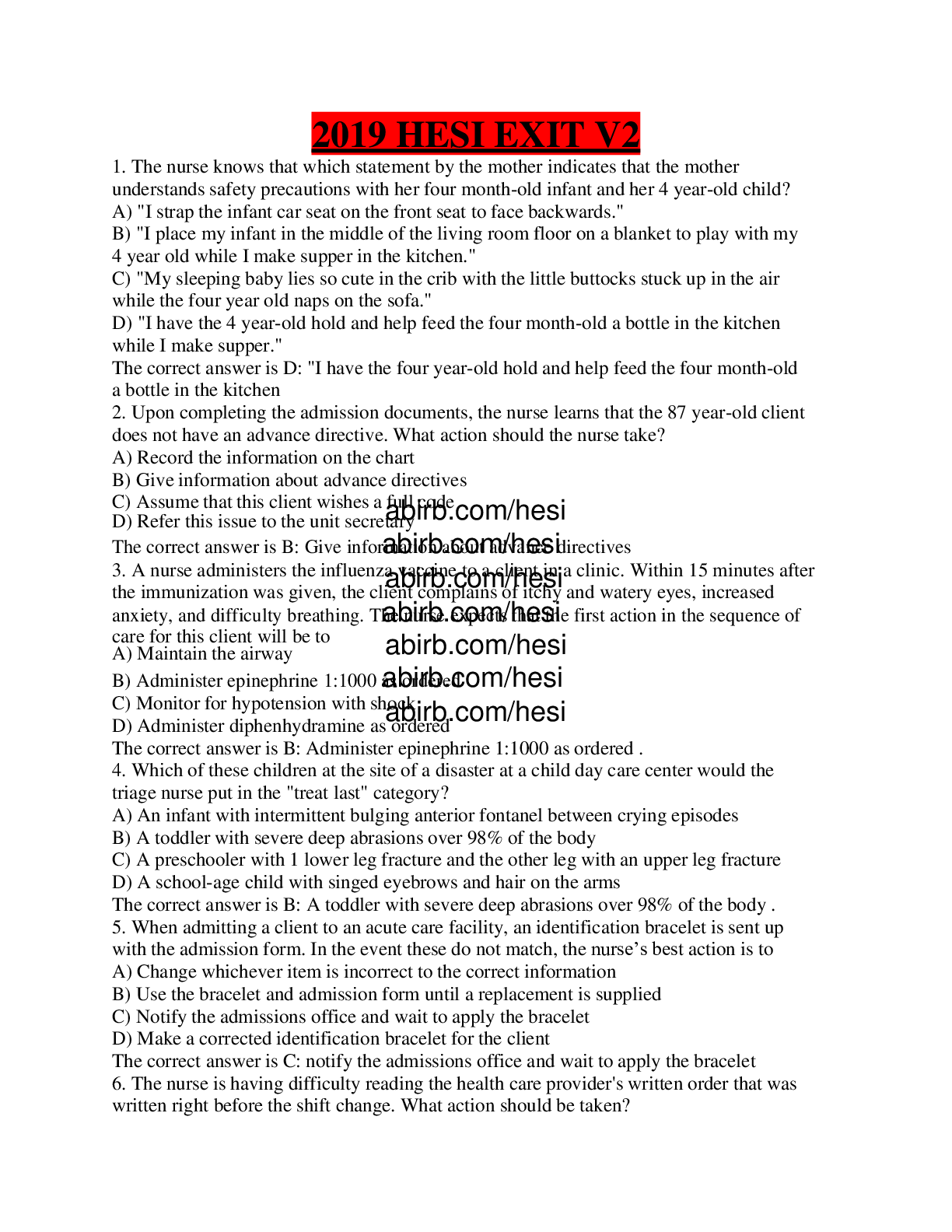
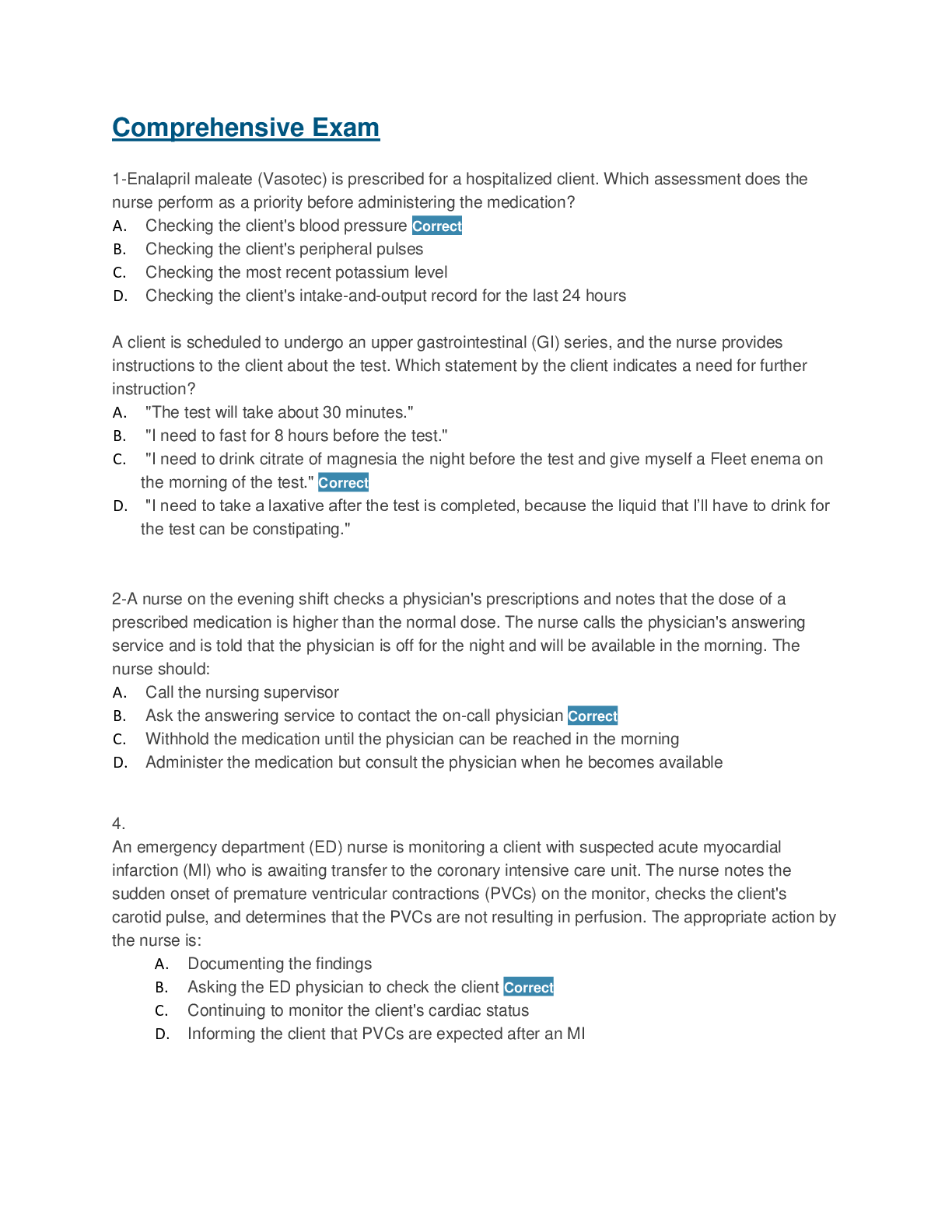
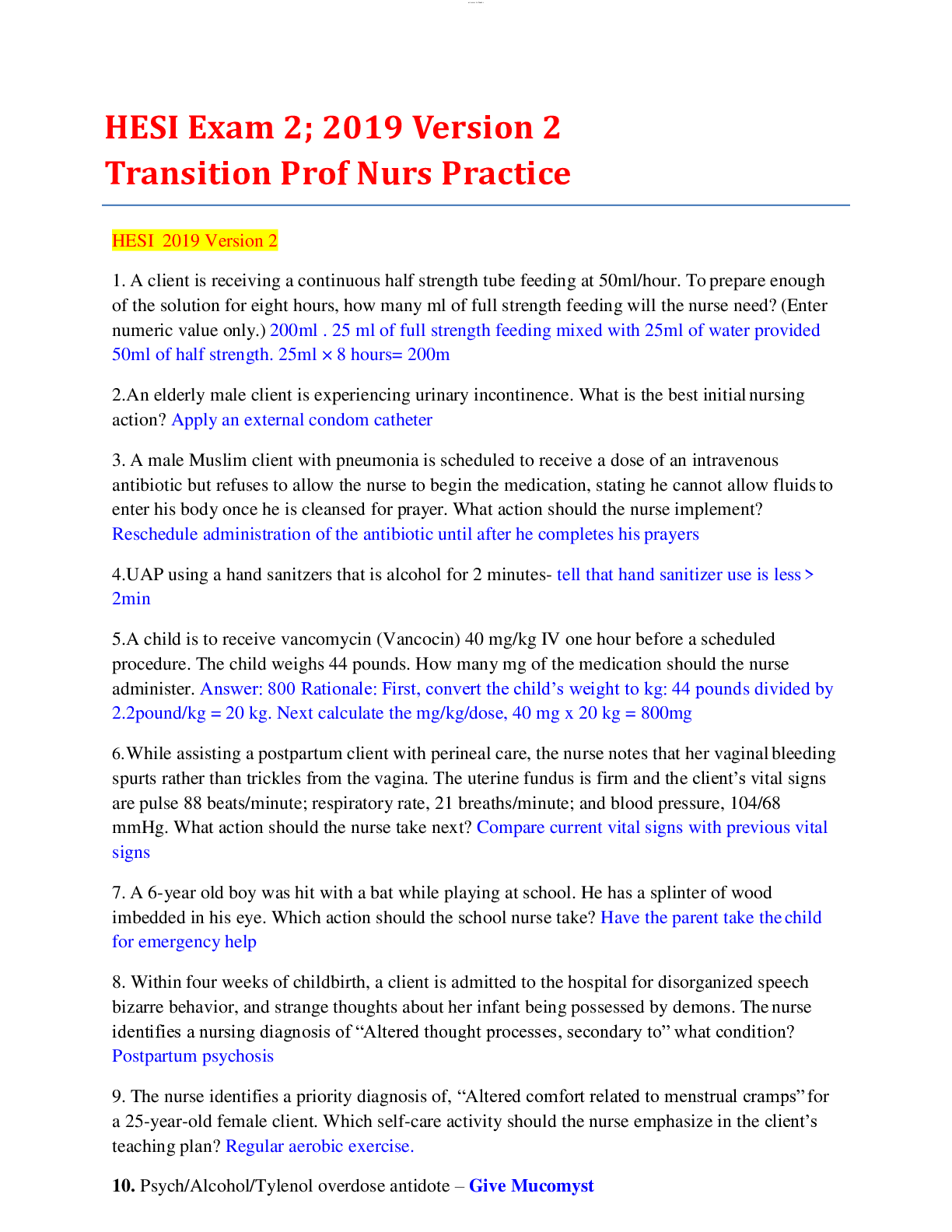
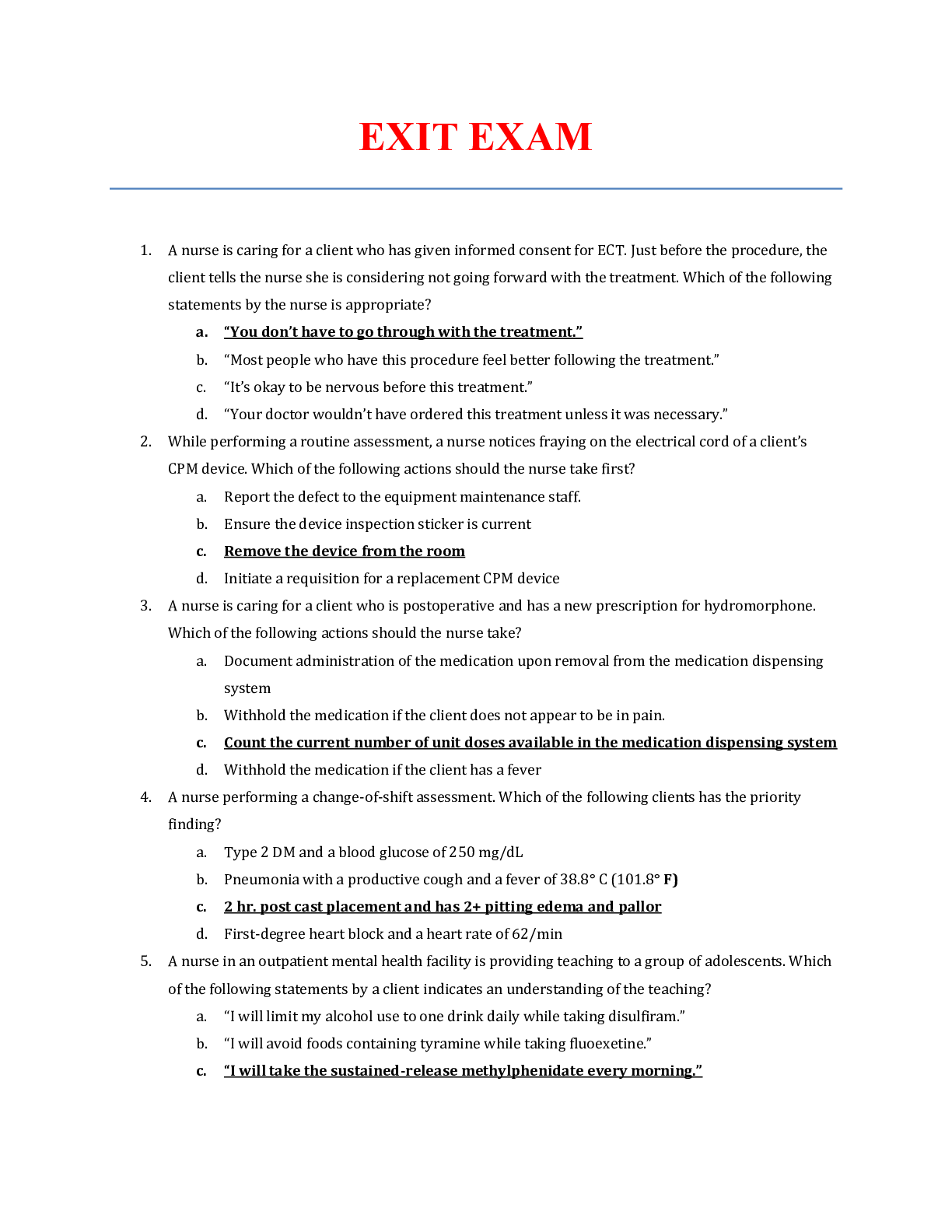
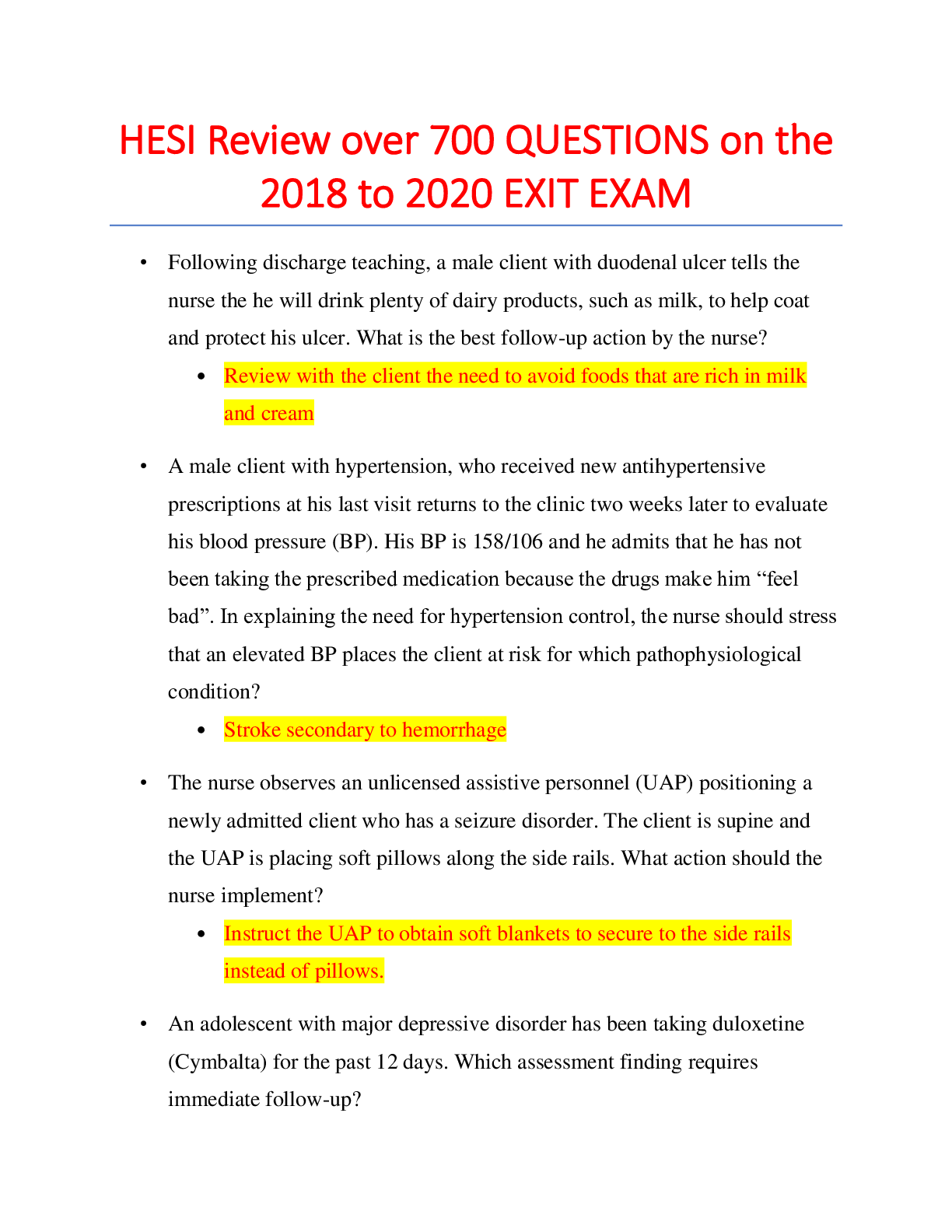
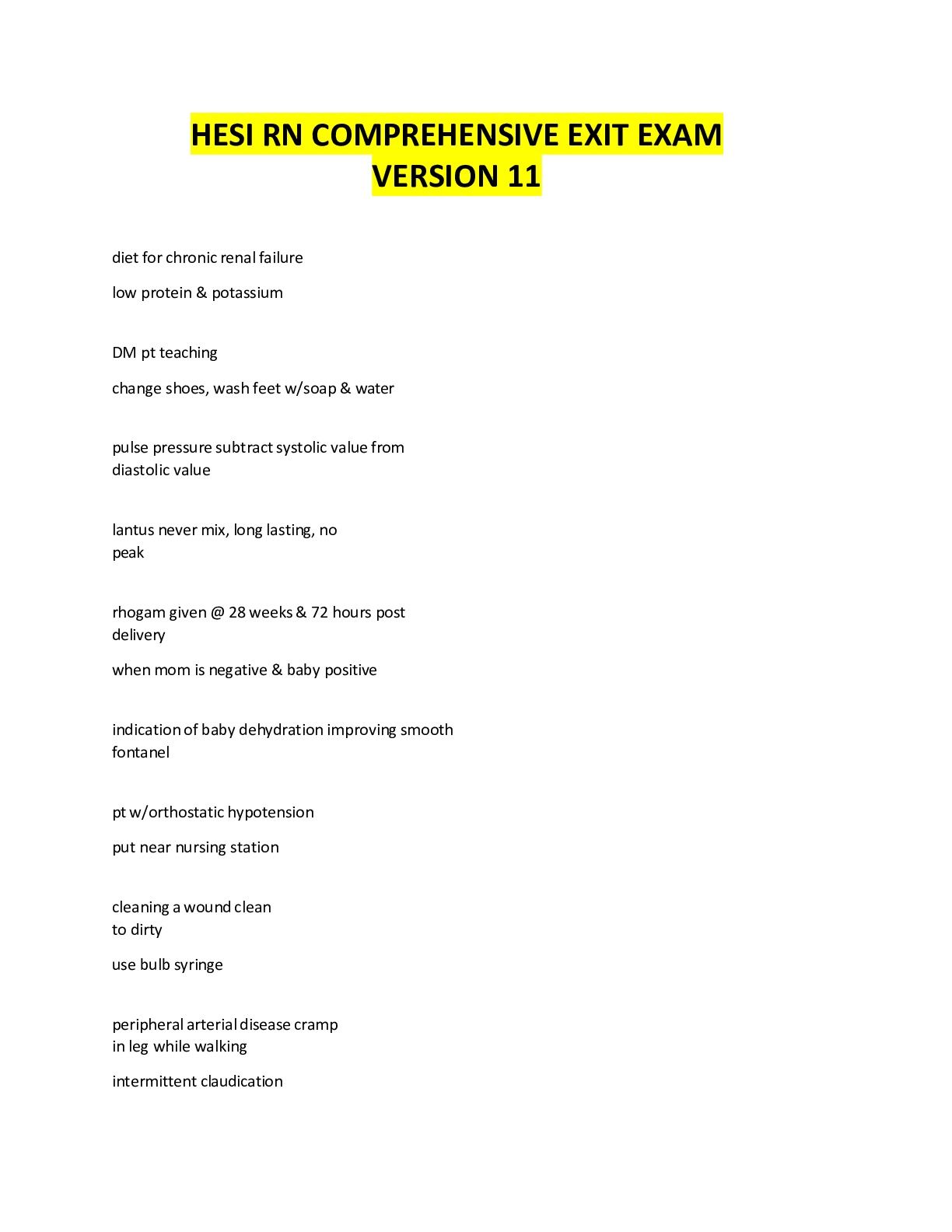
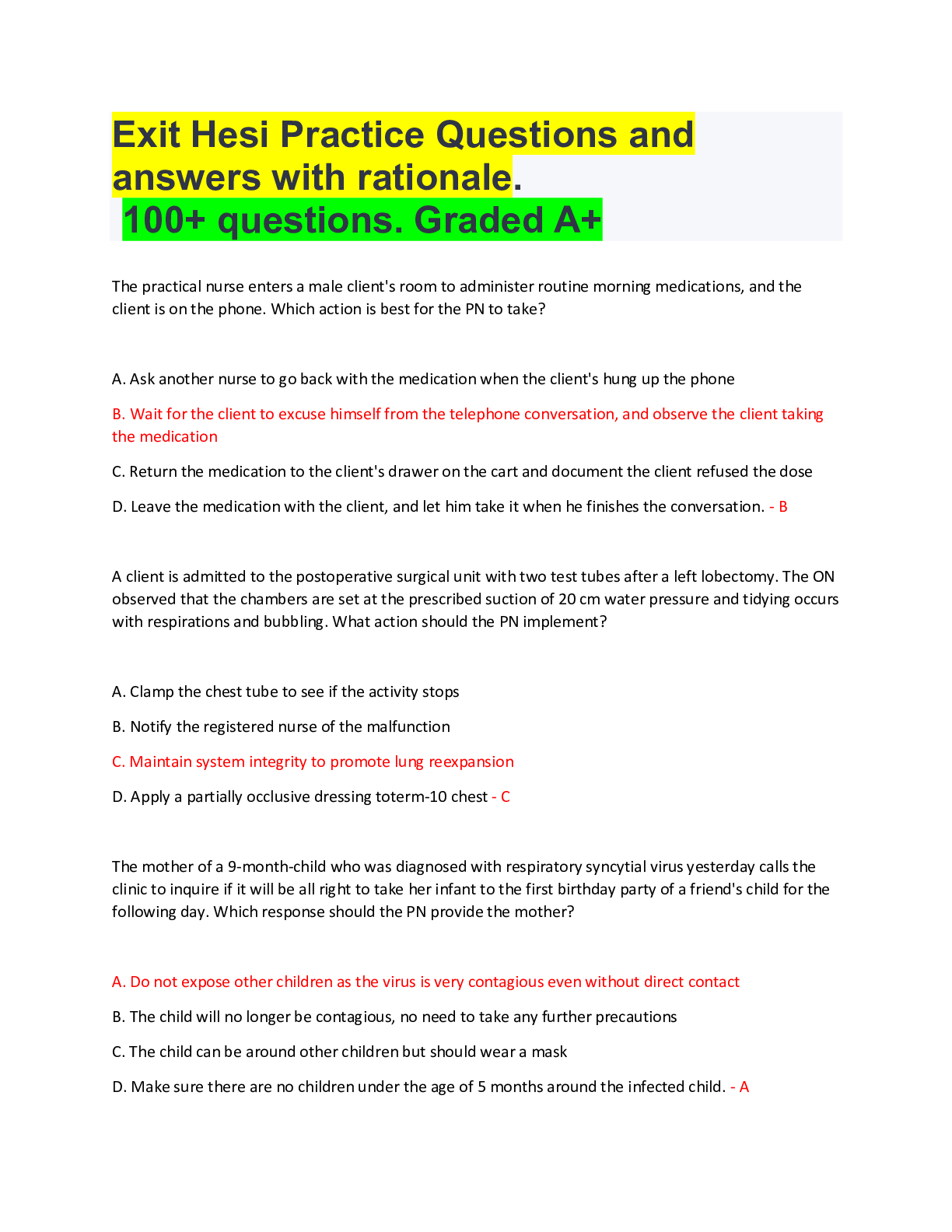
 100 QUESTIONS AND ANSWER(S) WITH RATIONALE TEST PREP GUIDE GRADED A+.png)
.png)
